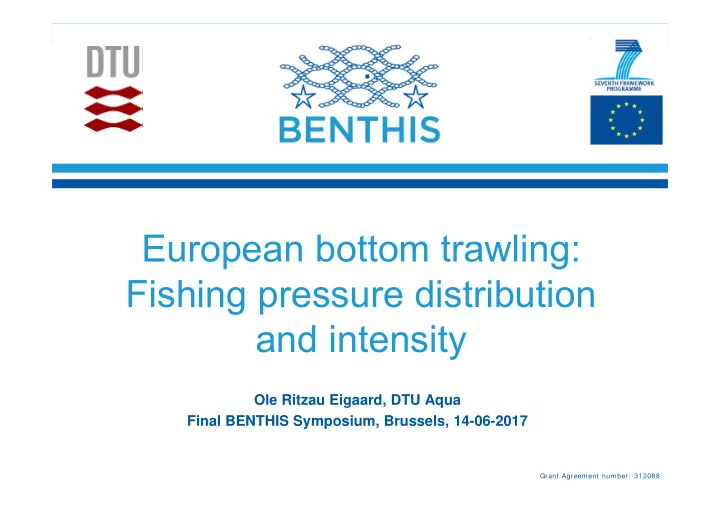

European bottom trawling: Fishing pressure distribution and intensity Ole Ritzau Eigaard, DTU Aqua Final BENTHIS Symposium, Brussels, 14-06-2017 Grant Agreement number: 312088
Mobile bottom contacting gears
Gear components with seabed contact Illustrations from SEAFISH 2016
Conceptual gear footprints
Parameterization of gear footprints • Size gear components from industry survey (1132 responses from 11 countries) • Penetration depth from literature review Country: Fishing area: Bottom trawls Date: BENTHIS ‐ 2013 vessel: (partner) Trawl type and name Trawling mode* one or two vessels (single or pair trawling) Rigging number of trawls per vessel Net maker company name Codend stretched mesh size (mm) single species fishery: cod, plaice, Nephrops, etc. or mixed fishery: "cod, haddock and saithe", Target species "nephrops and monkfish", etc. (common name(s) + FAO ‐ code) Bottom type bedrock, hard bottom, sand, hard clay, mud Vessel engine power in kW tonnage in GRT Loa: overall length in metres Trawl circumference number of meshes stretched mesh size (mm) Trawl Trawl height (metres) Wing spread (metres) Doors pelagic or bottom number producer and model length (m) height (m) weight (kg) Door spread door spread (metres) Sweeps sweep length (metres) Bridles number and length (metres) Tickler chains/lines number total weight of each chain or line (kg) Groundgear length of groundgear (metres) type, e.g. rockhopper, bobbins, discs, etc. diameter of ground ‐ gear (mm) total weight of ground gear (kg) Clump type (e.g. chain or roller) weight of clump (kg) Other chains in gear number and location in gear total weight of each (kg) * In cases of pair trawling, it is sufficient with vessel information (kW, Lenght and GRT) from the vessel/skipper intervie Trawling speed (knots): Steaming speed (knots): Fuel consumption trawling (litres/hour): Fuel consumption steaming (litres/hour): Consumption other activities (litres/hour and activity):
Gear footprints by metier Subsurface (abrasion ≥ 2 cm) Surface (abrasion < 2 cm)
High-resolution mapping of fishing pressure from VMS and logbook data a) Extract trawling positions in VMS data based on speed profiles b) Interpolate vessel tracks from vessel speed and course c) Merge with modelled gear footprint size in logbook data to provide swept area d) Aggregate swept areas by year in gridcells of 1×1 min (longitude and latitude)
European wide map of trawling intensity in 1x1 min grid cells (approx. 2 km 2 ) Local trawling hot spots (intensity >10) exist in most management areas Highest average intensities (0-200m depth zone) in Adriatic Sea, Tyrrhenian Sea, off Portugal, Bay of Biscay, and Skagerrak
Footprint seabed – study period/short term ( % seabed area trawled ≥ 1x yearly) Only parts of the management areas trawled (black+grey) Between 15% and 72% of the seabed area untrawled (white) Trawling is aggregated with 90% of effort (black) in about 2/3 of footprint (black+grey)
Footprint grid cell – long term perspective (% of grid cells trawled at any intensity) With this footprint metric, larger areas are trawled (black+grey) Between 1 and 47 % of the seabed area is untrawled (white) Trawling is more highly aggregated with 90% of effort (black) in about 50% of footprint
Trawling is extensive in all soft-sediment habitats, with grid cell footprints >70% for the 0-200m depth zone
Footprint estimates are scale dependent Skagerrak • Trawling is mostly 55 km randomly distributed at fine scale (around 1x1 km), and becomes more structured with larger scale • This distribution pattern is poorly captured by large scale analyses /grid cells, and footprints will typically be overestimated Denmark • Bias increases with the OT_#1 OT_#2 scale of analyses/size of OT_#3 grid cells. SDN SSC TBB OT_#4
Overall conclusions • Bottom trawls, seines and dredges are very different in design, dimensions and deployment and have very different gear footprints • Over longer time periods, trawling is highly aggregated with 90% of all trawling effort occurring in only 50 % of the trawled grid cells • This implies room for significant reductions of trawling impact at a minimal cost to the fishery • The proportion of the sea floor that was untrawled in the study period varied between 15 – 72 % for the different management areas • Highest trawling intensities were recorded in Adriatic Sea, Tyrrhenian Sea, Bay of Biscay, Skagerrak, and off Portugal • Trawling occurs extensively over all soft sediment habitats with long term footprints of more than 70%
Recommend
More recommend